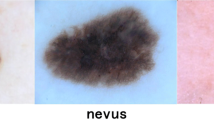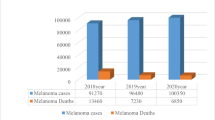Abstract
Due to melanoma is one of the skin cancers with the highest mortality rate and have a large amount of data during the collection and diagnosis, there is an urgent need to improve the diagnostic efficiency and accuracy. However, there remain problems in analyzing medical big data for skin lesion application, such as the intra-class variation and inter-class similarity in skin lesion images and the lacks of ability to focus on the lesion area affecting the classification results of the model. To address these dilemmas, in this paper, we proposed a novel machine learning-based approach that builds on top of DenseNet. It combines the attention mechanism and large margin loss to enhance the classification accuracy in terms of intra-class compactness and inter-class separability. We evaluated our model on ISIC 2017 (International Skin Imaging Collaboration) dataset, which has achieved 92% of Mean AUC. The experimental results show the effectiveness of our solution outperforms the state-of-the-art significantly in classify skin lesion and can accurately classify malignant melanoma on medical images.












Similar content being viewed by others
References
Gai, K., Qiu, M., & Zhao, H. (2016). Security-aware efficient mass distributed storage approach for cloud systems in big data. In IEEE International conference on big data security on cloud.
Chen, M., Zhang, Y., Qiu, M., Guizani, N., & Hao, Y. (2018). Spha: Smart personal health advisor based on deep analytics. IEEE Communications Magazine, 56(3), 164–169.
Siegel, L., Miller, K.D., & Jemal, A. (2019). Cancer statistics. CA: A Cancer Journal for Clinicians, 69(1), 2019.
American Cancer Society. (2019). Cancer facts & figures 2018, american cancer society, atlanta 2018.
Jones, O.T., Jurascheck, L.C., Van Melle, M., Hickman, S., Burrows, N.P., Hall, P.N., Emery, J., & Walter, F.M. (2019). Dermoscopy for melanoma detection and triage in primary care: a systematic review. BMJ Open, 9(8), e027529.
Apalla, Z., Nashan, D., Weller, B., & Castellsagué, X. (2017). Skin cancer: Epidemiology, disease burden, pathophysiology, diagnosis, and therapeutic approaches. Dermatology and Therapy, 7(Suppl 1), 5–19.
Kittler, H., Pehamberger, H., Wolff, K., & Binder, M. (2002). Diagnostic accuracy of dermoscopy. Lancet Oncology, 3(3), 159–165.
Dai, W., Qiu, M., Qiu, L., Chen, L., & Wu, A. (2017). Who moved my data? privacy protection in smartphones. IEEE Communications Magazine, 55(1), 20–25.
Dai, W., Qiu, L., Wu, A., & Qiu, M. (2018). Cloud infrastructure resource allocation for big data applications. IEEE Transactions on Big Data, 4(3), 313–324.
Gai, K., Qiu, M., Zhao, H., & Sun, X. (2018). Resource management in sustainable cyber-physical systems using heterogeneous cloud computing. IEEE Transactions on Sustainable Computing, p. 1–1.
Lecun, Y., Bengio, Y., & Hinton, G. (2015). Deep learning. Nature, 521(7553), 436.
Hu, Z., Tang, J., Wang, Z., Zhang, K., & Sun, Q. (2018). Deep learning for image-based cancer detection and diagnosis — a survey. Pattern Recognition, p. 83.
Hu, Z., Tang, J., Zhang, P., & Patlolla, B.P. (2018). Identification of bruised apples using a 3-d multi-order local binary patterns based feature extraction algorithm. IEEE Access, 6, 34846–34862.
Song, H., Huang, Y., Cai, W., & Zhou, Y. (2015). Large margin local estimate with applications to medical image classification. Medical Imaging, IEEE Transactions on, 34(6), 1362–1377.
Tu, W., Liu, X., Hu, W., & Pan, Z. (2019). Dense-residual network with adversarial learning for skin lesion segmentation. IEEE Access, 7, 77037–77051.
Simonyan, K., & Zisserman, A. (2014). Very deep convolutional networks for large-scale image recognition. arXiv e-prints, page arXiv:1409.1556.
He, K., Zhang, X., Ren, S., & Sun, J. (2016). Deep residual learning for image recognition. In 2016 IEEE Conference on computer vision and pattern recognition (CVPR), pp. 770–778.
Huang, G., Liu, Z., Van Der Maaten, L., & Weinberger, K.Q. (2017). Densely connected convolutional networks. In 2017 IEEE Conference on computer vision and pattern recognition (CVPR), pp. 2261–2269.
Elsayed, F., Krishnan, D., Mobahi, H., Regan, K., & Bengio, S. (2018). Large margin deep networks for classification. In Proceedings of the 32nd international conference on neural information processing systems, NIPS’18, page 850–860, Red Hook, NY, USA. Curran Associates Inc.
Xu, K., Ba, J., Kiros, R., Cho, K., Courville, A., Salakhutdinov, R., Zemel, S., & Bengio, Y. (2015). Show, attend and tell: Neural image caption generation with visual attention. In Proceedings of the 32nd international conference on international conference on machine learning - Volume 37, ICML’15, page 2048–2057 JMLR.org.
Krishna, R., Zhu, Y., Groth, O., Johnson, J., Hata, K., Kravitz, J., Chen, S., & Kalantidis, Y. (2017). Visual genome: Connecting language and vision using crowdsourced dense image annotations. International Journal of Computer Vision, 123(1), 32–73.
Zhang, H., Kyaw, Z., Chang, S., & Chua, T. (2017). Visual translation embedding network for visual relation detection. In 2017 IEEE Conference on computer vision and pattern recognition (CVPR), pp. 3107–3115.
Hu, J., Shen, L., & Sun, G. (2018). Squeeze-and-excitation networks. In 2018 IEEE/CVF conference on computer vision and pattern recognition, pp. 7132–7141.
Chen, L., Zhang, H., Xiao, J., Nie, L., Shao, J., Liu, W., & Chua, T. (2017). Sca-cnn: Spatial and channel-wise attention in convolutional networks for image captioning. In 2017 IEEE Conference on computer vision and pattern recognition (CVPR), pp. 6298–6306.
Wang, F., Jiang, M., Qian, C., Yang, S., Li, C., Zhang, H., Wang, X., & Tang, X. (2017). Residual attention network for image classification. In 2017 IEEE Conference on computer vision and pattern recognition (CVPR), pp 6450–6458.
Gessert, N., Sentker, T., Madesta, F., Schmitz, R., Kniep, H., Baltruschat, I., Werner, R., & Schlaefer, A. (2020). Skin lesion classification using cnns with patch-based attention and diagnosis-guided loss weighting. IEEE Transactions on Biomedical Engineering, 67(2), 495–503.
Yan, Y., Kawahara, J., & Hamarneh, G. (2019). Melanoma recognition via visual attention. Berlin: Springer Cham.
Zhang, J., Xie, Y., Xia, Y., & Shen, C. (2019). Attention residual learning for skin lesion classification. IEEE Transactions on Medical Imaging, 38(9), 2092–2103.
Ganster, H., Pinz, P., Rohrer, R., Wildling, E., Binder, M., & Kittler, H. (2001). Automated melanoma recognition. IEEE Transactions on Medical Imaging, 20(3), 233–239.
Tommasi, T., Torre, E., & Caputo, B. (2006). Melanoma recognition using representative and discriminative kernel classifiers. In Second Eccv international conference on computer vision approaches to medical image analysis.
A, M.E.C., A, H.A.K., A, B.U., D, H.I., A, Y.A.A., B, W.V.S., & C, R.H.M. (2007). A methodological approach to the classification of dermoscopy images. Computerized Medical Imaging and Graphics, 31(6), 362–373.
Ge, Z, Demyanov, S, Chakravorty, R, Bowling, A, & Garnavi, R. (2017). Skin disease recognition using deep saliency features and multimodal learning of dermoscopy and clinical images.
Yu, L., Chen, H., Dou, Q., Qin, J., & Heng, P. (2017). Automated melanoma recognition in dermoscopy images via very deep residual networks. IEEE Transactions on Medical Imaging, 36(4), 994–1004.
Romero Lopez, A., Giro-i-Nieto, X., Burdick, J., & Marques, O. (2017). Skin lesion classification from dermoscopic images using deep learning techniques. In 2017 13th IASTED international conference on biomedical engineering (BioMed), pp. 49–54.
Esteva, A., Kuprel, B., Novoa, A., Ko, J., & Thrun, S. (2017). Corrigendum: Dermatologist-level classification of skin cancer with deep neural networks. Nature, 546(7660), 686–686.
Zhang, J, Xie, Y, Wu, Q, & Xia, Y. (2018). Skin lesion classification in dermoscopy images using synergic deep learning.
Zhang, J., Xie, Y., Wu, Q., & Xia, Y. (2019). Medical image classification using synergic deep learning. Medical Image Analysis.
Szegedy, C., Vanhoucke, V., Ioffe, S., Shlens, J., & Wojna, Z. (2016). Rethinking the inception architecture for computer vision. In 2016 IEEE Conference on Computer Vision and Pattern Recognition (CVPR), pp. 2818–2826.
Codella, N.C.F., Gutman, D., Celebi, M.E., Helba, B., Marchetti, M.A., Dusza, S.W., Kalloo, A., Liopyris, K., Mishra, N., Kittler, H., & Halpern, A. (2018). Skin lesion analysis toward melanoma detection: a challenge at the 2017 international symposium on biomedical imaging (isbi), hosted by the international skin imaging collaboration (isic). In 2018 IEEE 15th International Symposium on Biomedical Imaging (ISBI), vol. 2018, pp. 168–172.
Matsunaga, K., Hamada, A., Minagawa, A., & Koga, H. (2017). Image classification of melanoma, nevus and seborrheic keratosis by deep neural network ensemble 03.
González Dıaz, I. (2017). Incorporating the knowledge of dermatologists to convolutional neural networks for the diagnosis of skin lesions. IEEE Journal of Biomedical and Health Informatics, 23.
Menegola, A., Tavares, J., Fornaciali, M., Li, L, Avila, S., & Valle, E. (2017). Recod titans at isic challenge. 03.
Bi, L., Kim, J., Ahn, E., & Feng, D. (2017). Automatic skin lesion analysis using large-scale dermoscopy images and deep residual networks 03.
Yang, X., Zeng, Z., Yeo, S., Tan, C., Tey, H., & Su, Y. (2017). A novel multi-task deep learning model for skin lesion segmentation and classification 03.
DeVries, T. (2017). D Ramachandram. Skin lesion classification using deep multi-scale convolutional neural networks. 03.
Author information
Authors and Affiliations
Corresponding author
Additional information
Publisher’s Note
Springer Nature remains neutral with regard to jurisdictional claims in published maps and institutional affiliations.
Rights and permissions
About this article
Cite this article
Wu, J., Guo, H., Wen, Y. et al. Medical Big Data Analysis with Attention and Large Margin Loss Model for Skin Lesion Application. J Sign Process Syst 93, 827–839 (2021). https://doi.org/10.1007/s11265-021-01664-0
Received:
Revised:
Accepted:
Published:
Issue Date:
DOI: https://doi.org/10.1007/s11265-021-01664-0




